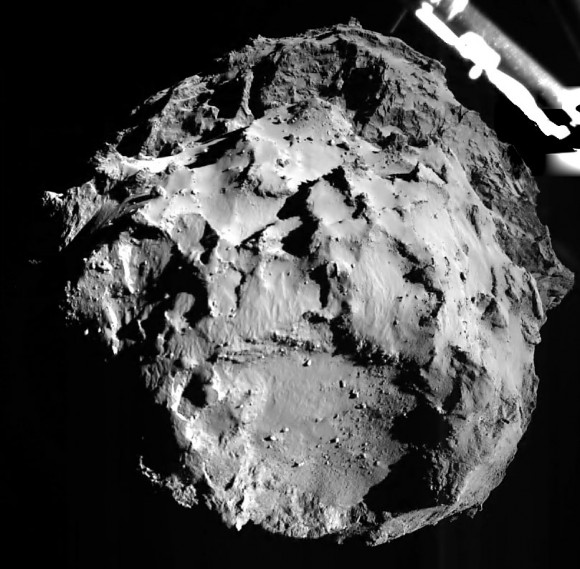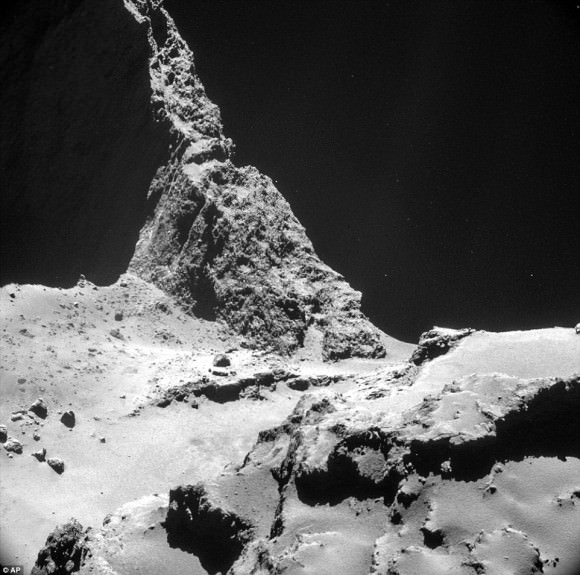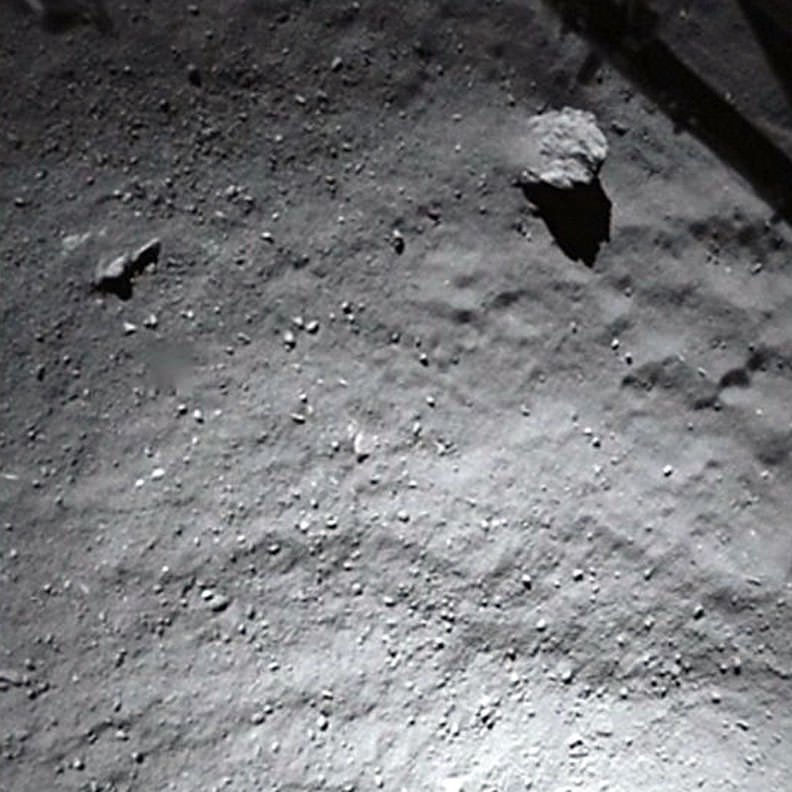
Hey, we’re getting closer! This photo was taken by Philae’s ROLIS instrument just 1.8 miles (3 km) above the surface of 67P/Churyumov-Gerasimenko at 8:38 a.m. (CST) today. The ROLIS instrument is a down-looking imager that acquires images during the descent and doubles as a multi-wavelength close-up camera after the landing. The aim of the ROLIS experiment is to study the texture and microstructure of the comet’s surface. ROLIS (ROsetta Lander Imaging System) is a descent and close-up camera on the Philae lander.
I know, I know. You got a fever for more comet images the way Christopher Walken on Saturday Night Live couldn’t get enough cowbell.

Key scientists in a media briefing this afternoon highlighted the good news and the bad news about the landing. We reported earlier that both the harpoons and top thrusters failed to fire and anchor the lander to the comet. Yet land it did – maybe more than once! A close study of the data returned seems to indicate that Philae, without its anchors, may have touched the surface and then lifted off again, turning itself from the residual angular momentum left over after its flywheel was shut down. Stephan Ulamec, Philae Landing Manager, got a appreciative laugh from the crowd when he explained it this way: Maybe today we didn’t just land once. We landed twice!”

Telemetry from the probe has been sporadic. Data streams come in strong and then suddenly cut out only to return later. These fluctuations in the radio link obviously have the scientists concerned and as yet, there’s no explanation for them. Otherwise, Philae landed in splendid fashion almost directly at the center of its planned “error ellipse”.
Instruments on Philae are functioning normally and gathering data as you read this. Ulamec summed up the situation nicely: “It’s complicated to land and also complicated to understand the landing.”
Scientists and mission control will work to hopefully resolve the harpoon and radio link issues. The next live webcast begins tomorrow starting at 7 a.m. (CST). Although nothing definite was said, we may see more images arriving still today, so stop by later.


From this snapshot angle it looks like an impact cracked the comet in two halfs. With impact angle from left to right.
I hope that the ESA team manages to sort out the ankering of Philae.
Zoutsteen. The huge “crater” on the ducks head is too large to be an impact . I am not a comet or asteroid expert but knowledgeable enough to understand that such a crater would have split the lobe in half. nearly all the craters on the surface are due to subsidence from sublimation – solids to gas – leading to ground collapse.
Note also that Rollis camera points straight down so the landing site is likely right in the middle of the 1024×1024 image. But there is transverse motion which offsets the landing point from the center of the image. AD ASTRA!
Thanks for your observations on this Tim. According to the latest press conference, Philae landed squarely in the center of its error ellipse. Nice job by ESA!
I think this is absolutely wonderful. But I must admit that I am getting impatient with the lack of images from the surface. Why is ESA taking so long for a panoramic shot? It took less time to get telemetry from the Venus missions in the 70’s.
There is a bit of an issue regarding releasing images, related to the camera team, which translates to 6 months wait for publicly available data. We are supposed to be happy with one image per week, if.
http://blogs.esa.int/rosetta/2014/07/16/access-to-rosetta-data/
Emily Lakdawalla has more details regarding images :
“The most-anticipated data was from the ÇIVA panoramic imager. Although the imaging sequence executed, there was a problem with the data that was returned to Earth; it had black stripes or bars or was just black. It’s unclear what went wrong, especially since ÇIVA worked great during descent. They may ask Philae to re-run the ÇIVA sequence while the rest of the science sequence is executing (they can apparently do this in parallel) in order to try to get this important image observation acquired and on the ground.”
http://www.planetary.org/blogs/emily-lakdawalla/2014/11120821-philae-has-landed.html
I think what went wrong is the lander bounced and began to spin above the surface. This explains the intermittent signal. Also the images were impossible to get because of the movement. The lander only took 2 pictures. One on descent and the other just before touchdown. When it falls back to the surface again, if it does, it may end up on its side or crash. Once it “lands” a picture should be possible that would verify its orientation. If it isn’t sending a picture, then it is still spinning in space. The intermittent signal should stop when it settles. If the signal is still intermittent, it’s not on the ground. It may have bounced much higher than they realize as the relative weight is only 1-2 grams. It could be a mile above the surface right now. Its possible the harpoon did fire and the lander recoiled. Without the thruster to counteract the harpoon it could have recoiled quite high. The intermittent signal means it is spinning above the surface. Now if it lands again there is no way to orient it.
It’s a known quantity that it did indeed land and bounced only once.
The lack of images might be due to the sporadic communications as they explained Philae may be sending corrupt packets so images might be incomplete or indecipherable. Another big question- is Philae generate power from the solar panels. If not then it’s time live on the comets will be I think three days on the battery pack charged up prior to descent.
Philae has a dampener in its central shaft that connects the body to the landing legs . The dampener absorbed much of the shock of landing but all. The circumstances faced with this comet required a faster descent rate which may be more than the dampener could absorb. The harpoons are really a contingency to deal with bounce.
Itching here too wanderingman.
Thanks Bob, you are great…!
I couldn’t see the real landing image that was shoving the harpoon, also…
It was available two hours before…
Whoa Nelly.. Philae actually ‘bounced’ three times! The first bounce was almost 2 hours long! YIKES! I wonder if the orbiter will see ‘footprints’ from any of those ‘touch and goes’? Bonus?
3 bounces! Wow. Just woke up. Need to catch up on status
The Public interest in these images should be a priority for ESA they should not delay and show us what they have before they lose public support for future missions,This is a Big Disappointment from ESA…